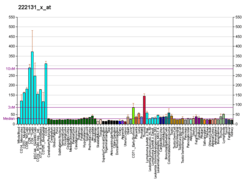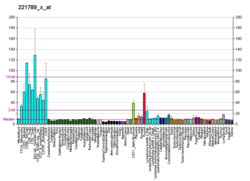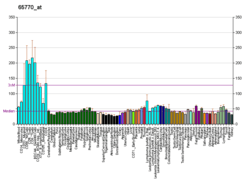RHOT2
Mitochondrial Rho GTPase 2 is an enzyme that in humans is encoded by the RHOT2 gene.[4][5] As a Miro protein isoform, the protein facilitates mitochondrial transport by attaching the mitochondria to the motor/adaptor complex.[6] Through its key role in mitochondrial transport, RHOT2 is involved in mitochondrial homeostasis and apoptosis, as well as Parkinson’s disease (PD).[6][7]
Structure
In mammals, RHOT2 is one of two Miro isoforms. Both isoforms share a structure consisting of two EF-hand motifs linking two GTP-binding domains and a C-terminal transmembrane domain that attaches the protein to the outer mitochondrial membrane (OMM).[6][8] The EF-hand motifs serve as binding sites for the adaptor protein Milton and the kinesin heavy chain.[9] These domains can also bind calcium ions, and the binding results in a conformational change that dissociates the mitochondrial surface from kinesin.[6][8]
Function
RHOT2 is a member of the Rho GTPase family and one of two isoforms of the protein Miro: RHOT1 (Miro1) and RHOT2 (Miro2).[6][9] Compared to the rest of the Rho GTPase family, the Miro isoforms are considered atypical due to their different regulation.[10] Moreover, the Miro isoforms are only expressed in the mitochondria.[11]
Miro associates with Milton (TRAK1/2) and the motor proteins kinesin and dynein to form the mitochondrial motor/adaptor complex. Miro functions to tether the complex to the mitochondrion while the complex transports the mitochondrion via microtubules within cells.[6][7] Though Miro has been predominantly studied in neurons, the protein has also been observed to participate in the transport of mitochondria in lymphocytes toward inflamed endothelia.[9]
The motor/adaptor complex is regulated by calcium ion levels. At high concentrations, calcium ions arrest mitochondrial transport by binding Miro, causing the complex to detach from the organelle. Considering that physiological factors such as activation of glutamate receptors in dendrites, action potentials in axons, and neuromodulators may elevate calcium ion levels, this regulatory mechanism likely serves to keep mitochondria in such areas to provide calcium ion buffering and active export and, thus, maintain homeostasis.[6]
In addition, Miro regulates mitochondrial fusion and mitophagy in conjunction with mitofusin. According to one model, damaged mitochondria are sequestered from healthy mitochondria by the degradation of Miro and mitofusin. Miro degradation halts their movement while mitofusin degradation prevents them from fusing with healthy mitochondria, thus facilitating their clearance by autophagosomes. [6]
Clinical significance
Studies indicate that Miro may be involved in PD.[7] In neurons, Miro interacts with two key proteins involved in PD, PINK1 and Parkin.[6] Following depolarization of the mitochondria, PINK1 phosphorylates Miro at multiple sites, including S156, and Parkin ubiquitinates Miro, targeting it for proteasomal degradation.[6][7] Degradation of Miro then halts mitochondrial transport.[6]
Though the Rho GTPase family is closely associated with cancer progression, there are few studies demonstrating such association with the atypical Miro proteins.[10]
Interactions
RHOT1 has been shown to interact with:
- ALEX3,[6]
- DISC1,[11]
- Dynein,[6]
- HUMMR,[6]
- kinesin heavy chain (KHC),[6]
- Mitofusin (MFN1/MFN2),[6]
- Milton (TRAK1/TRAK2),[6]
- Parkin,[6]
- PINK1,[6] and
- OGT.[6]
References
- GRCm38: Ensembl release 89: ENSMUSG00000025733 - Ensembl, May 2017
- "Human PubMed Reference:". National Center for Biotechnology Information, U.S. National Library of Medicine.
- "Mouse PubMed Reference:". National Center for Biotechnology Information, U.S. National Library of Medicine.
- Fransson A, Ruusala A, Aspenström P (Feb 2003). "Atypical Rho GTPases have roles in mitochondrial homeostasis and apoptosis". The Journal of Biological Chemistry. 278 (8): 6495–502. doi:10.1074/jbc.M208609200. PMID 12482879.
- "Entrez Gene: RHOT2 ras homolog gene family, member T2".
- Schwarz TL (Jun 2013). "Mitochondrial trafficking in neurons". Cold Spring Harbor Perspectives in Biology. 5 (6): a011304. doi:10.1101/cshperspect.a011304. PMC 3660831. PMID 23732472.
- van der Merwe C, Jalali Sefid Dashti Z, Christoffels A, Loos B, Bardien S (May 2015). "Evidence for a common biological pathway linking three Parkinson's disease-causing genes: parkin, PINK1 and DJ-1". The European Journal of Neuroscience. 41 (9): 1113–25. doi:10.1111/ejn.12872. PMID 25761903.
- Fransson S, Ruusala A, Aspenström P (Jun 2006). "The atypical Rho GTPases Miro-1 and Miro-2 have essential roles in mitochondrial trafficking". Biochemical and Biophysical Research Communications. 344 (2): 500–10. doi:10.1016/j.bbrc.2006.03.163. PMID 16630562.
- Morlino G, Barreiro O, Baixauli F, Robles-Valero J, González-Granado JM, Villa-Bellosta R, Cuenca J, Sánchez-Sorzano CO, Veiga E, Martín-Cófreces NB, Sánchez-Madrid F (Apr 2014). "Miro-1 links mitochondria and microtubule Dynein motors to control lymphocyte migration and polarity" (PDF). Molecular and Cellular Biology. 34 (8): 1412–26. doi:10.1128/MCB.01177-13. PMC 3993592. PMID 24492963.
- Jiang H, He C, Geng S, Sheng H, Shen X, Zhang X, Li H, Zhu S, Chen X, Yang C, Gao H (2012). "RhoT1 and Smad4 are correlated with lymph node metastasis and overall survival in pancreatic cancer". PLOS ONE. 7 (7): e42234. doi:10.1371/journal.pone.0042234. PMC 3409151. PMID 22860091.
- Ogawa F, Malavasi EL, Crummie DK, Eykelenboom JE, Soares DC, Mackie S, Porteous DJ, Millar JK (Feb 2014). "DISC1 complexes with TRAK1 and Miro1 to modulate anterograde axonal mitochondrial trafficking". Human Molecular Genetics. 23 (4): 906–19. doi:10.1093/hmg/ddt485. PMC 3900104. PMID 24092329.
Further reading
- Daniels RJ, Peden JF, Lloyd C, Horsley SW, Clark K, Tufarelli C, Kearney L, Buckle VJ, Doggett NA, Flint J, Higgs DR (Feb 2001). "Sequence, structure and pathology of the fully annotated terminal 2 Mb of the short arm of human chromosome 16". Human Molecular Genetics. 10 (4): 339–52. doi:10.1093/hmg/10.4.339. PMID 11157797.
- Aspenström P, Fransson A, Saras J (Jan 2004). "Rho GTPases have diverse effects on the organization of the actin filament system". The Biochemical Journal. 377 (Pt 2): 327–37. doi:10.1042/BJ20031041. PMC 1223866. PMID 14521508.
- Shan Y, Hexige S, Guo Z, Wan B, Chen K, Chen X, Ma L, Huang C, Zhao S, Yu L (2004). "Cloning and characterization of the mouse Arht2 gene which encodes a putative atypical GTPase". Cytogenetic and Genome Research. 106 (1): 91–7. doi:10.1159/000078568. PMID 15218247.
- Colland F, Jacq X, Trouplin V, Mougin C, Groizeleau C, Hamburger A, Meil A, Wojcik J, Legrain P, Gauthier JM (Jul 2004). "Functional proteomics mapping of a human signaling pathway". Genome Research. 14 (7): 1324–32. doi:10.1101/gr.2334104. PMC 442148. PMID 15231748.
- Rual JF, Venkatesan K, Hao T, Hirozane-Kishikawa T, Dricot A, Li N, Berriz GF, Gibbons FD, Dreze M, Ayivi-Guedehoussou N, Klitgord N, Simon C, Boxem M, Milstein S, Rosenberg J, Goldberg DS, Zhang LV, Wong SL, Franklin G, Li S, Albala JS, Lim J, Fraughton C, Llamosas E, Cevik S, Bex C, Lamesch P, Sikorski RS, Vandenhaute J, Zoghbi HY, Smolyar A, Bosak S, Sequerra R, Doucette-Stamm L, Cusick ME, Hill DE, Roth FP, Vidal M (Oct 2005). "Towards a proteome-scale map of the human protein-protein interaction network". Nature. 437 (7062): 1173–8. doi:10.1038/nature04209. PMID 16189514.
- Fransson S, Ruusala A, Aspenström P (Jun 2006). "The atypical Rho GTPases Miro-1 and Miro-2 have essential roles in mitochondrial trafficking". Biochemical and Biophysical Research Communications. 344 (2): 500–10. doi:10.1016/j.bbrc.2006.03.163. PMID 16630562.




